2 Methods to Change Quiet Hours (Focus Assist) Automatic Rules
Some users have reported being unable to customize the automatic rules for the Quite hours feature in Windows 10. This is understandable considering the fact that the procedure and even the name have been altered with the latest Windows 10 builds.
What is Quiet Hours (Focus Assist)?
Quiet assist is a Windows feature that disables the showing of all notifications during a pre-determined period of time. Quiet Hours was introduces with the launch of Windows 8.1. This feature is meant to help those users that need to stay focused on what they’re doing without being interrupted by notifications.
If you previously used Windows 8, you might remember that you were previously able to configure Quiet Hours to turn On and Off at certain times. But for some reason, Microsoft decided to remove that customization menu for Windows 10 and only leave an On/Off toggle. By default, Windows 10 previously set Quiet Hours from 12 : 00 AM to 6 : 00 AM, with no option to change them from the user interface.
Starting with the Windows 10 build 17083, the Quiet Hours feature has been renamed to Focus Assist. Even if this change confused some users, the update also brought some additions to the classic Quiet Hours functionality:
- If you already updated to Windows 10 build 17074 or above, Focus Assist will automatically turn itself on whenever you are duplicating your display. This is a welcomed addition since it will prevent any interruptions during presentations and other similar activities.
- Focus Assist will also be turned on automatically whenever you play a game or run an application that is using DirectX.
- You can now customize a priority list that will allow important applications and people to penetrated the Focus Assist wall even when it’s turned on.
- With the new Cortana integration and geolocation services that were implemented, you can configure Focus Assist to turn on automatically at specific locations.
- If you already updated to Windows 10 build 17661, Focus Assist will automatically turn itself on whenever you are playing a full-screen game.
- You can see a summary of the things you missed while you were using Focus Assist.
Of course, if you are a technical person, you don’t have to rely on the default behavior. Focus Assist (Quiet Hours) allows you to set up your own schedule. You can select the activities where you don’t want to be disturbed, set manual hours, configure a priority list and even configure the service to enable itself only when you’re at home.
To make things easier for you, we configured two step by step guides on changing the automatic rules of Focus Assist (Quiet Hours). If you already have Windows 10 build 17083 or above, follow Method 1. If you’re still using an older Windows 10 build (older than build 17083) in which this feature is still named Quiet Hours, follow Method 2 to change the Quiet Hours by Editing the Registry.
Method 1: Changing the Focus Assist Automatic rules in Windows 10
The following steps were written in an attempt to give you a basic overview on how you can change the automatic rules of the Focus Assist feature on Windows 10. But keep in mind that the following steps are only applicable if you are already on Windows 10 build 17083 or above.
Note: If your build is older than Windows 10 build 17083, jump straight to Method 2.
Here’s a quick guide on how to change the default configuration of Focus Assist on Windows 10:
- Click on the Start icon (bottom-left corner) and then click on the Settings icon (cog wheel).
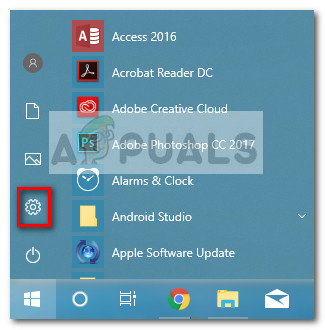
- In the Windows Settings menu, click on System and then use the left-hand panel to open the Focus Assist menu.
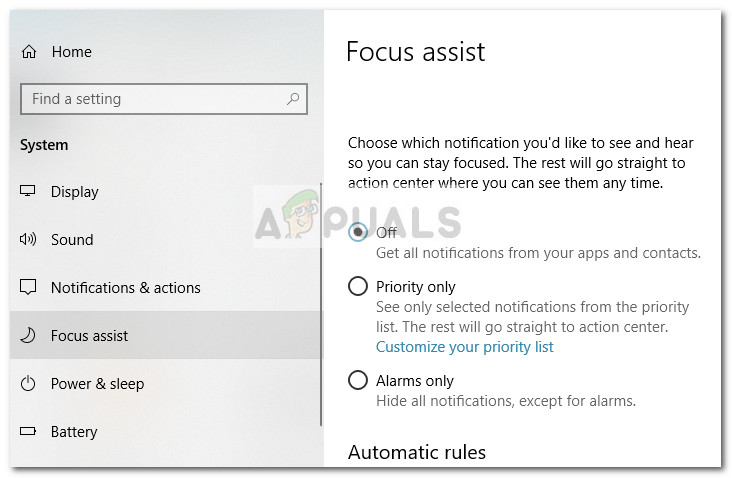 Note: You can also open the Focus Assist window menu directly via a Run box. To do this, open a new Run window (Windows key + R), type “ms-settings:quiethours” and hit Enter.
Note: You can also open the Focus Assist window menu directly via a Run box. To do this, open a new Run window (Windows key + R), type “ms-settings:quiethours” and hit Enter. - Under Automatic rules, you can now freely enable or disabled the rules from the list.
- You can set custom hours when you want Focus Assist to be automatically enabled by clicking the During these times. In the During these hours screen, you can set the Start time and the End time along with the Repeat frequency and the Focus level. Once you configure everything according to your preference, make sure that the toggle at the top is set to ON, then hit the back arrow to return to the previous screen.

- If you want to avoid being disrupted when playing a game or doing a presentation, make sure the toggles associated with When I’m duplicating my display and When I’m playing a game are turned On. Keep in mind that both of these options can be clicked and configured based on the Focus level.

- You can also configure Focus Assist to automatically enable itself whenever you are home by enabling the When I’m at home toggle. But keep in mind that the option will be greyed out if Cortana doesn’t know your address. To enable this option, click on Give Cortana permissions, choose Settings and make sure that Location is enabled.
Note: Keep in mind that this option might not be available depending on your location. - Finally, you can check the box associated with Show a notification in action center when focus assist is turned on automatically. This will provide you with an overview of the things you missed every time you exit Focus Assist.
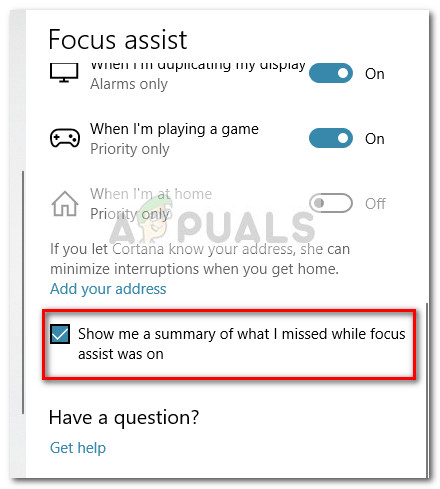
- Once the configuration is according to your preference, you can close the Settings menu.
Method 2: Changing Quiet Hours via Registry Editor
If you don’t want to update to Windows 10 build 17083 or above, you have no UI-enabled way to modify the standard quiet hours. However, there is a workaround that will enable you to set custom hours for when the Quiet Hours feature to kick in.
Note: This guide won’t be applicable if your Windows 10 build is older than 17083.
This guide will involve editing the Registry, but you run no risk of damaging your PC if you follow the instructions closely. But just to be sure, we are going to show you how to backup your registry in case something goes terribly wrong.
Here’s a quick guide on how to modify the default Quiet Hours using Registry Editor:
- Press Windows key + R to open up a new Run box. Then, type “regedit“, hit Enter, then click on Yes at the UAC (User Account Control) to open Registry Editor.

- Inside Registry Editor, go to the ribbon at the top and choose File > Export. Then, choose a location, and a name for the file and hit OK to create a backup for your registry files.
 Note: In the event that something goes wrong, you can return to Registry Editor, go to File > Import and choose the backup file to return your registry to a healthy state.
Note: In the event that something goes wrong, you can return to Registry Editor, go to File > Import and choose the backup file to return your registry to a healthy state. - Once the backup is in place, use the left-hand-side pane of Registry Editor to navigate to the following registry key:
HKEY_CURRENT_USER \ SOFTWARE \ Policies \ Microsoft \ Windows \ CurrentVersion
- Next, right-click on the CurrentVersion key and choose New > Key to create a new key and name it QuietHours.
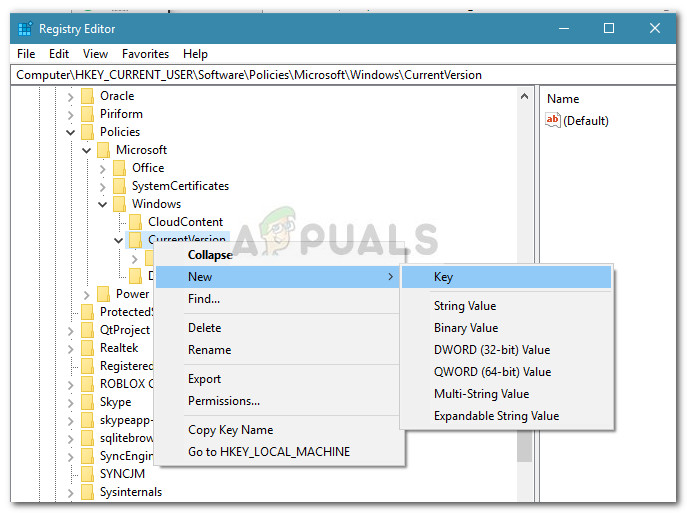
- Next, we are going to create two separate values inside the QuietHours key. To do this, right-click on the QuietHours key and choose New > DWord (32-bit) Value and name the new value EntryTime. Then, create the second DWORD value using the same procedure and name it ExitTime.
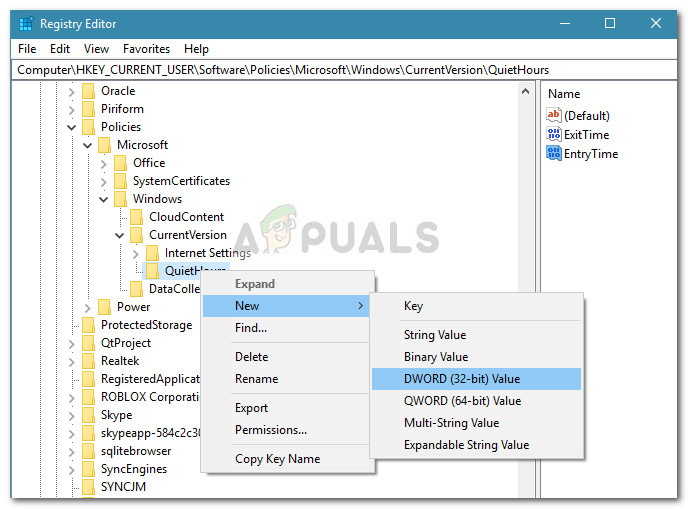
- Keep in mind that EntryTime is the time when Quiet Hours begin and ExitTime value is the value that holds the ending period. Next, open a value by double-clicking on it and set the Base option to Decimal. Now, in the Value Data box, type the number of minutes after midnight that you want to trigger the event. For example, if you want to set the EntryTime to 3 : 00 AM, set the value to 180 and hit OK.

- Repeat the same procedure with the second value until both EntryTime and ExitTime are configured correctly.
- Once both values are configured, you can close Registry Editor. There’s no need to restart your PC as the changes take place as soon as you save them.





